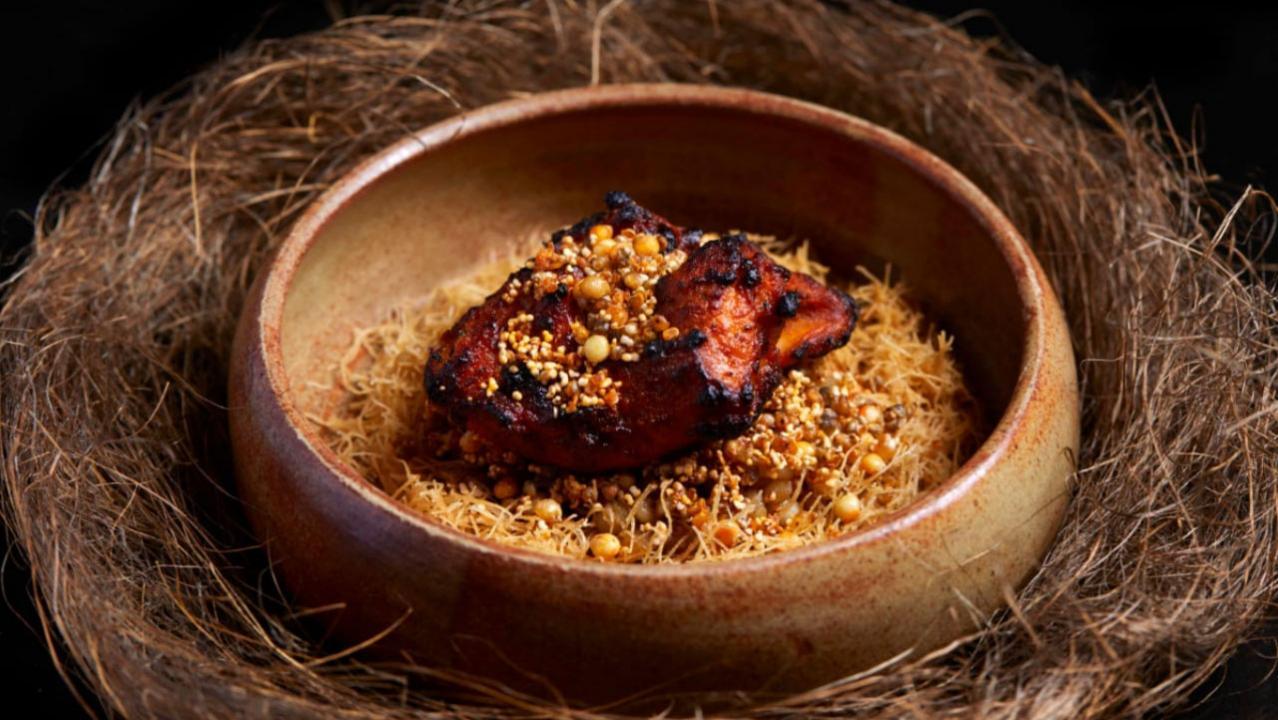
Mumbai-based chef Vanika Choudhary is currently fermenting two different kinds of millets at her city restaurant Noon. The city chef, who is the founder of two BKC restaurants, the other being Sequel, has been using millets since she started both her restaurants in the city in the last one year and seven years respectively. She explains, “For finger millet miso, we have taken the whole millet, ambemohar rice koji and fermented it for six months to make a sweet miso which is used in desserts. Another kind of millet miso that we are experimenting with is proso millet with Kashmiri red chillies from my parent`s garden in Jammu, we have fermented this for a year and the result is this bold, earthy, slightly spicy and deeply umami flavour. No one has ever made miso using a millet.”
There has been an active buzz around millets since the start of the year. It has been further aided by the fact that the United Nations declared 2023 as the ‘Year of Millets’ after receiving a proposal from India, as our country wished to position itself as a hub for millet from the agricultural aspect. Incidentally, Indians have eaten and enjoyed millets for the longest time because they have been making a variety of dishes not only for breakfast but also for lunch and dinner as it forms an integral part of our diet.
Unsurprisingly, as an extension of diner’s needs, restaurants have also been making use of millets but other than traditional dishes, they have also been using millets to make unique dishes that are will make people look at the group of grains in a new light, and this is much before 2023 and Choudhary is one of them.
Every grain matters
For her, the grain is beyond just an ingredient that she uses in dishes. It is an emotion she has translated into many forms, one that starts from her home where she uses it in khichdi, sourdough bread and a dosa too. The latter of which is one of the dishes that featured on the menu at Sequel for almost two years, she says. The mouth-watering dish is a Ghee Roast Finger Millet Dosa served with coconut-peanut chutney, charred oyster mushrooms and curry leaf podi. “It is inspired by the dosa I first fed my toddler when he started baby-led weaning – just when he was nine months old and it was time to introduce him to different grains. It’s made using an heirloom variety of ragi called ‘Karun Ragi’ which translates to ‘Black’, the ragi is soaked overnight, sprouted for three days, sun-dried and then stone milled into flour.” Grown by a farmer collective in Tamil Nadu`s Dharmapuri, it is her ode to the traditional way of consuming grains.
At Noon, it`s no different because she doesn`t have only one but at least two dishes putting a spotlight on heritage grains. The first dish is a delicious mix of Kodai avocado and cape gooseberry salsa with starfruit and kanji-spiced shallots and charred tiger prawns in sprouted finger millet tortillas. The second one takes the opportunity to remind people of the humble jowar bhakri, which she has reimagined as a tortilla and serves it with green tomato and habanero salsa, charred Barramundi, fermented white onions in kokum kefir and coriander microgreens. While they are constantly innovative with the dishes, she has been using the grains at the two restaurants since they launched. Like Punjabi, Chowdhary says a deeper understanding of how Indians eat millets has made her work with them better. “Soaking them overnight and then fermenting them reduces the phytic acid present in these grains and makes it easier for our body to digest them,” she adds. Currently, apart from karun ragi, she boasts of using proso millet and a rare variety of sorghum called ‘red jowar` to name a few.
Sweet and savoury
Choudhary isn’t the only chef that has elevated or reimagined the use of millets in food in Mumbai. City-based restaurant Masala Library by Jiggs Kalra also uses millets in a variety of ways simply because they form an integral part of the Indian pantry and the greater story of Indian food at large, according to chef Rahul Punjabi, executive chef at the restaurant. They are not only used to make traditional dishes like khichdi but are also cooked, dried and puffed to be used as a garnish for other dishes. “Millets are a great starch element and are wonderful vessels to carry flavour,” explains Punjabi, while highlighting how they add a textural element to the dishes they become a part of.
The restaurant serves ‘Bird in its Nest’, a dish where millets are the star ingredient. He describes, “We use their flavour carrying properties to make a rich pearl barley and wild mushroom khichdi, this is emulsified with butter to have an almost slippery and unctuous mouthfeel.” The city chef says that’s not only because for the garnish they use other millets like kuttu, jowari, bajri and rajgira too. “We puff them using different cooking techniques like pan roasting and deep frying to get different crunchy textures.”
Using millets has been a journey of discovery for Punjabi like Choudhary has had over the years. Even more so because he only just started experimenting with the grains recently and is still in the nascent stage. While making India’s most favourite food khichdi was the more obvious choice, drying and puffing them, boiling, draining and using them as a salad eventually followed. “Now, we are experimenting with making batters and flours with them to use in new dishes – kuttu flour for gluten-free naans,” he shares. Believing in the diversity of millets, they experiment with the likes of kuttu, jowari, bajri, rajgira, pearl barley and have in the past also used kangni. “We ran a special caviar service a few months ago with a fermented ragi pikelet (an Australian pancake that`s used as a caviar accompaniment,” he adds.
Like Punjabi, chef Paul Kinny at St Regis Mumbai also uses millets to make gluten-free flour that is used for all their baked goods. He shares, “As a whole grain in khichdi, pulao, upmas, healthy salads. Puffed whole grain proso millet is also consumed as breakfast cereal using the technology of gun puffing – which is trending today.” Since the nature of the bread is sweet, says Kinny, it becomes versatile to use in a variety of dishes.
Its use has even evolved in the kitchens of St Regis Mumbai, according to the city chef. While it was earlier used in the flour form, today they use it as whole grain in not only salads and upmas but also risotto and pasta. Among the many different types, the five-star property uses finger millet, foxtail millet, pearl millet, proso millet, little millet and sorghum millet.
Interestingly, Kinny says it is used in a dessert at the city property unlike Punjabi. He explains, “The Millet Savarin dessert recipe is made with millet flour replacing the glutinous starch-based regular flour making this dessert not only gluten-free but promises a rich sweet deliciousness and to the ring-shaped Savarin cake soaked with flavoured syrup and garnished with cream and fruit.”
Elsewhere in Bandra, chef Rahul Desai at Bloom Café also builds on the fact that that millets are not only nutritious but also gluten-free and in the process uses it to make bread as well as risotto and salad. “I use pearl barley millet to replace arborio rice in a risotto. Pearl barley has a pleasant chewy and slightly sticky texture, similar to tapioca and is a phenomenal substitute for arborio rice as it also provides the starch to make the risotto thick and creamy,” he shares. As far as the salad goes, he has used pearl barley to with smoked Scamorza cheese, granny smiths and pomegranates with an orange mustard dressing. With so much variety on offer, pearl barley is only one of others like ragi, amaranth, jowar and buckwheat to make different kinds of wraps, and breads and buns.
Desai’s love for millets is evident not from the fact that he makes baked goods but from the fact that he takes the luxury of replacing the traditional ingredient used in Italian dishes to turn them into something new. Apart from the risotto, he has also made use of the grains to make a polenta. “It is a classic northern Italian dish made of yellow cornmeal and replaced the cornmeal with amaranth and proso millet. I made thin steaks after solidifying them and served it a pumpkin and sage brown butter sauce. Personally, I love Polenta and the millet definitely blends well with the dish,” says Desai, while expressing his happiness that millets are finally back in demand, after he observed them going out of fashion a few years ago. “It is refreshing to see them make a comeback on supermarket shelves. The pearl barley salad is one of the hot-sellers in one of our restaurants, validating the acceptance of millets in the current market. The awareness around the health benefits of millets, especially for vegetarians is increasing and this is one trend that is here to stay. It`s time for us to lead the way in this transition, especially because India is one of the world`s largest exporters of millets,” he shares.
At ITC Grand Central, chef Ruffy Shaikh is taking off from where Desai imagines the status of millets in India. The five-star property has planned a variety of dishes that use millets as their star ingredients at the Hornby’s Pavillion. “Millets contain six times more fiber than wheat and definitely helps keep the glycemic index low and it is gluten free. Thus, making it the most voted for grain amongst people who wish to stay fit and has dietary requirements. They are mainly grown in hard, arid and drought prone regions and are readily available at a very low cost so it helps restaurants across the hospitality sector maintain business at an affordable cost as well,” he shares. In such a major effort, the restaurant has the likes of finger millet idli, hari mirch saunf jowar roti, pearl millet and brown rice poha, little millet and jaggery pancake, bajra aur khajoor barfi – all of which certainly set the tone for the year during which millets will be celebrated in more ways than one.
Also Read: Get rad about radish: Spice up the unsung winter vegetable with these chef tips
Stay connected with us on social media platform for instant update click here to join our Twitter, & Facebook
We are now on Telegram. Click here to join our channel (@TechiUpdate) and stay updated with the latest Technology headlines.
For all the latest Food and Drinks News Click Here
